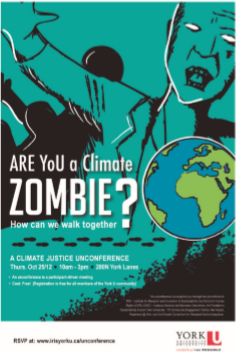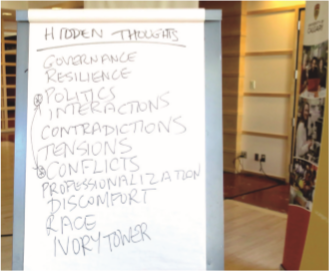How the unconference approach can increase
stakeholder engagement
Cómo el enfoque de Desconferencia puede aumentar el
compromiso de las partes
interesadas
DAWN R. BAZELYa, ANNETTE DUBREUILb AND LUSHANI NANAYAKKARAc
aDepartment of Biology, York University, Toronto, ON Canada M3J 1P3, dbazely@yorku.ca
bCanada’s Ecofiscal Commission, c/o Department of Economics, McGill University, 855 Sherbrooke Street West, Montreal, QC H3A 2T7
cDepartment of Biology, University of Regina, Regina, SK Canada S4S 0A2
DOI: http://dx.doi.org/10.24133/rvespe.v3i1.616
ABSTRACT:
Researchers in the fields of environmental science, conservation biology
and sustainability studies recognize the importance of engaging
stakeholders. Due to implicit or unconscious bias, it is highly likely that
when researchers prepare their lists of people and groups who may be
affected by, or interested in, their research, some stakeholders will be
omitted. Use of Open Space Technology, part of the Unconference
engagement framework, in the early stages of research, can diversify
and increase stakeholder participation.
KEYWORDS:
Stakeholder engagement, Open Space Technology, OST,
unconference, science policy, invasive species.
RESUMEN:
Investigadores en los campos de ciencias ambientales, biología de
conservación, y sostenibilidad reconocen la importancia de involucrar a
la comunidad beneficiaria. Debido a un sesgo implícito o inconsciente,
es muy probable que cuando los investigadores preparan sus listas
de personas y grupos que pueden ser afectados o interesados en
su investigación, algunas partes interesadas pueden ser omitidas. El
uso de la tecnología de espacio abierto en las primeras etapas de la
investigación, dentro del marco de referencia de la desconferencia,
puede diversificar y aumentar la participación de las partes interesadas.
PALABRAS CLAVE:
Participación de los interesados, Conferencia de Espacio Abierto,
desconferencia, Política científica, especies invasoras.
INTRODUCTION
In the Brothers Grimm fairy tale, The Sleeping Beauty, seven (or 12) fairies
are invited to the christening of a baby princess. The first six (or 11) fairies
grant the baby gifts, including beauty, and goodness. Just before the
seventh (or 12th) fairy gives her gift, an old fairy, that everyone thought
was dead, gate-crashes the party. Angry at not having been invited, the
forgotten fairy curses the baby princess with death, when she pricks her
finger on a spinning wheel spindle. The seventh (or 12th) fairy cannot
entirely reverse the curse. But she can transform it, saying that when the
princess pricks her finger, she will not die. Instead, she will fall into a deep
sleep, from which she can only be wakened by the kiss of a prince.
Imagine, for a moment, what would have happened if the baby’s parents
had known about the importance of stakeholder engagement, and known
that there might be gaps in their invitation list? If the king and queen had
invited everyone to the christening, perhaps the forgotten fairy would not
have been so upset, and we would not have this fairy tale, and the Disney
movie!
This technical note has three objectives:
1. To illustrate how engaging stakeholders in environmental management
research can give insights that scientists would not, otherwise, gain.
2. To connect the goal of stakeholder engagement with equity, diversity
and inclusivity (EDI) policy and research.
3. To describe how the Unconference (Budd et al., 2017), including
Open Space Technology (Owen, 2008) can increase stakeholder
inclusivity and participation.
Researchers want to engage stakeholders
A search of the Web of Science database for articles containing the phrase
“stakeholder engagement” returned one article in 2000, 65 articles in
2010, and 322 articles in 2016. A similar search in SCOPUS returned 2
articles in 2000, 118 in 2010, and 462 in 2017.
Today, environmental scientists readily acknowledge that efforts to
safeguard vulnerable habitats from a multitude of threats, must include the
human dimension. Large-scale conservation efforts require the support of
diverse public groups, including members of local communities, in order
to successfully meet their objectives (Christie et al., 2017).
Knowledge about stakeholder perceptions of conservation, environmental
and sustainability projects, and their social impacts, is key for researchers
seeking local support for their plans (Bennett, 2016). Conversely, a lack
of stakeholder engagement can result in critical knowledge gaps between
scientists and non-scientists, leading to failures in policy, planning, and
project implementation (Nanayakkara & Wissel, 2017).
How a stakeholder survey shaped a science-policy narrative
A study of prairie lakes in southern Saskatchewan, Canada, explicitly
incorporated both human dimensions, and lake ecosystem dynamics
(Nanayakkara & Wissel, 2017; Nanayakkara et al., 2017). A
stakeholder survey assessed perceptions of lake use, climate change,
invasive species, water quality (eutrophication), water extractions, and
lake management. Themes emerging from this survey included sport fish
and invasive species, which in turn, helped in organizing ecosystem data
from limnological surveys. Data collected on the physical, chemical,
and biological parameters of lakes, informed by the stakeholder survey,
enabled the authors to study watershed dynamics directly related to the
survey’s emerging themes.
This interdisciplinary approach provided a more holistic picture of these
heavily used prairie lakes, by giving insights into under-studied stakeholder
perceptions. For example, some stakeholders were unaware that nonindigenous
zebra and quagga mussels were not present in Saskatchewan.
Because the lake-users surveyed thought that these invasive species were
already present, they were less likely to clean their boats, leading to an
increased likelihood of ‘accidental’ introductions of these mussels to uninvaded
lakes.
Understanding stakeholder perceptions, and critical knowledge gaps,
helped to identify more effective, cohesive narratives for scientific
knowledge transfer and science communication. Stakeholders were
primarily concerned about sport-fish, so the discussion of invasive species
addressed how zebra mussels and other non-native species specifically
impact these valuable species (Nanayakkara et al., 2017; Nanayakkara
& Wissel, 2017).
Engagement as an equity, diversity and inclusivity issue
Finding ways of successfully incorporating human dimensions into largescale
biological conservation planning cannot be an afterthought. While
local stakeholders are an integral part of the conservation equation, they
are often left out of critical aspects of decision-making (Bennett, 2016).
Strategies for increasing stakeholder engagement include interdisciplinary
collaborations, clear written and verbal communication, actionable
advice, and identifying a salient narrative that frames scientific findings in
a context that makes their policy-relevance clearer (Burgman, 2015; Leslie
et al., 2013; Rose, 2015; Rose et al., 2016). However, these strategies
all assume that researchers have identified and contacted all possible
stakeholders. How do researchers know that this is the case? What if they
have failed to identify a potentially disgruntled, forgotten fairy?
We all have implicit or unconscious biases (Project Implicit, 2011).
Therefore, it is vital that researchers planning to include a stakeholder
engagement dimension in their project, acknowledge this, and take
conscious steps to discover and include unexpected stakeholders.
In the for-profit business sector, companies with strong equity, diversity
and inclusion (EDI) policies perform better than those without them (Hunt,
Layton & Prince, 2015). Various techniques for increasing both EDI and
stakeholder engagement have developed in the fields of organizational
behaviour, and corporate social responsibility (Jeffery, 2009; Riordan,
2014).
Open Space Technology and unconferences at York University
The Unconference (Budd et al., 2017) approach aims to make stakeholder
engagement more diverse and inclusive. Unconferences are participantdriven
meetings. While the Unconference is a general category that
includes many different “emergent change” practices, for many people,
the Open Space Technology (OST) (Owen, 2008) meeting format has
become synonymous with the Unconference. Emergence describes a
“higher-order complexity arising out of chaos in which novel, coherent
structures coalesce through interactions among the diverse entities of a
system” (Holman, 2010).
In the Open Space Technology meeting format, participants co-create the
agenda at the beginning of the meeting. The agency of participants is
fostered by emphasizing that everyone who shows up is meant to be there.
OST (Owen, 2008) operates by four guiding principles, and the Law of
Two Feet:
1. “Whoever comes is the right people.
2. Whatever happens is the only thing that could have.
3. Whenever it starts is the right time.
4. When it is over, it is over.”
The Law of Two Feet emphasizes that each participant should do what
feels right for them during the meeting. If they are not learning or engaged
in a session, they should leave, or feel free to sit out for a while. If a topic
that the participant would like to discuss is not on the agenda, it is up
to them to suggest it be added, and to take the lead in facilitating that
small group. Regardless of the chosen emergent facilitation technique, it is
essential to create safe spaces that allow participants to share their views in
an authentic manner. Two brief videos by Collaborativeways1 (2013) and
Camp Stomping Ground (2015) describe the Open Space Technology
meeting format.
At IRIS, York University’s Institute for Research and Innovation in
Sustainability (2004-2015: http://iris.info.yorku.ca/projects/campus-
IncreaseStakeholderEngagement), we used the OST approach to shape
campus sustainability work in climate justice, food security and water
security in 2012-13. Results were used to develop future directions arising
from campus sustainability surveys (IRISyorku, 2013; SCLD, 2013). These
one-day events were advertised to all members of the campus community.
Participants set the agenda in the morning, followed by three concurrent
breakout sessions. The days closed with conclusions, and a summary.
The benefit, of using the OST method for facilitating stakeholder
engagement, was that it did not presuppose which aspects of a problem
would be of interest to the group, or who would attend. There is an implicit
understanding that everyone has a unique understanding, and perspective,
to bring to the problem, as well as a piece of the solution. By hearing these
multiple, sometimes, contradictory views, a clearer picture can emerge,
followed by the development of novel solutions.

Figure 1. Poster from York University,
Toronto’s Institute for Research
and Innovation in Sustainability,
advertising a unconference about
climate change and climate justice in
2012: “Are you a climate zombie?
How can we walk together?”
CONCLUSIONS
When done early in research projects, stakeholder engagement activities,
including stakeholder surveys, can identify knowledge gaps and policyrelevant
narratives.
The use of inclusive, non-judgmental Unconference formats, can increase
and diversify stakeholder participation. The Open Space Technology type
of Unconference that we described, provides a welcoming environment
in which every participant feels valued. Ultimately, gaining the input and
participation of less obvious stakeholders provides a more holistic picture
of the system of interest.

Figure 2. At the Professional Development Seminar on Transdisciplinary
Approaches to Integrating Policy and Science for Sustainability workshop
in October 2017, Dawn Bazely held a mini-uniconference during her
presentation. This is a list of topics that participants said that they would like to
discuss more during the meeting.
REFERENCES
Bennett, NJ. (2016) Using perceptions as evidence to improve conservation
and environmental management. Conservation Biology, 30: 582–592.
Budd, A. et al. (2017) Ten Simple Rules for Organizing an Unconference.
PLOS Computational Biology. https://doi.org/10.1371/journal.
pcbi.1003905
Burgman, M. (2015) Governance for Effective Policy-Relevant Scientific
Research: The Shared Governance Model. Asia and the Pacific Policy
Studies, 2: 441–451.
Camp Stomping Ground. (2015) “Open Space Technology Introduction”
Youtube video 1m45s, May 19, 2015. Accessed January 15, 2018.
https://youtu.be/M_jhcvCYBbg
Collaborativeways1. (2013) “Online Open Space Technology Meetings”
Youtube video 9m16s, Feb 28, 2013. Accessed January 15, 2018.
https://www.youtube.com/watch?v=QhNQ8Mhehpw.
Christie, P, et al. (2017) Why people matter in ocean governance: Incorporating
human dimensions into large-scale marine protected areas. Marine
Policy. 84: 273-284.
Holman, P. (2010) Engaging Emergence: Turning Upheaval into Opportunity.
Berrett-Koehler Publishers, San Francisco, California.
Hunt, V., Layton, D. and Prince, S. (2015) Diversity Matters. McKinsey and
Company. https://www.mckinsey.com/business-functions/organization/
our-insights/why-diversity-matters Accessed December 11, 2017.
IRIS-York University (irisyorku). (2013) “The agenda for the Food Unconference
is waiting for you to set the agenda! #yorku https://twitter.com/irisyorku/
status/308599438769803264” 10:26 AM EST - 4 Mar 2013.
Jeffery, N. (2009) Stakeholder Engagement: A Road Map to Meaningful
Engagement. The Doughty Centre for Corporate Responsibility, Cranfield
School of Management, Bedfordshire, UK. https://dspace.lib.cranfield.
ac.uk/handle/1826/3801
Leslie, H, et al. (2013) How Good Science and Stories Can Go Hand-In-
Hand. Conservation Biology, 27: 1126–1129.
Nanayakkara, L, & Wissel, B. (2017) Preliminary investigation of lakeuse
patterns in prairie lakes, stakeholder perceptions, and resulting
management implications. Lake and Reservoir Management, 33(1): 49-
61.
Nanayakkara, L, et al. (2017) In lakes but not in minds: stakeholder knowledge
of invasive species in prairie lakes. Biological Invasions. https://doi.
org/10.1007/s10530-017-1564-4
Owen, H. (2008) Open Space Technology: A User’s Guide, 3rd Edition.
Berrett-Koehler Publishers, San Francisco, California.
Project Implicit. (2011) Project Implicit at https://implicit.harvard.edu/implicit/
aboutus.html
Riordan, CM. (2014) Diversity Is Useless Without Inclusivity. Harvard Business
Review https://hbr.org/2014/06/diversity-is-useless-without-inclusivity
Accessed December 11, 2017
Rose, DC. (2015) The case for policy-relevant conservation science.
Conservation Biology, 29: 748–754.
Rose, DC, et al. (2016) Honest advocacy for nature: presenting a persuasive
narrative for conservation. Biodiversity and Conservation.
SCLD (YorkUscld). (2013) RT @irisyorku: The Food Unconference agenda to
date! Come join a discussion and grab some lunch top! #yorku https://
twitter.com/yorkuscld/status/308619680208281600” 11:47 AM EST -
4 Mar 2013

AUTHOR BIOGRAPHY:
Dawn R. Bazely is a University Professor
in Biology, York University, Canada. Former
director of the Institute for Research and
Innovation in Sustainability (IRIS). Her research
focuses on the science-policy-politics nexus. She
advocates for citizen science, and for scientists
to be better public science communicators.


